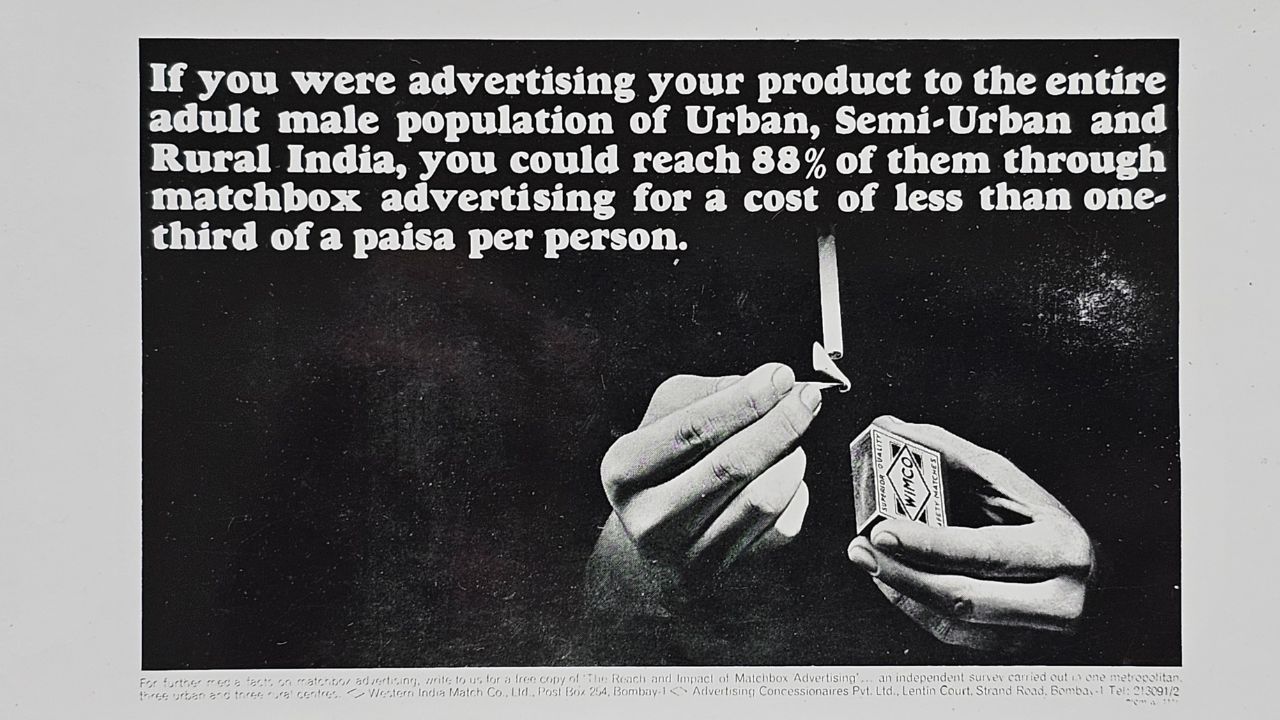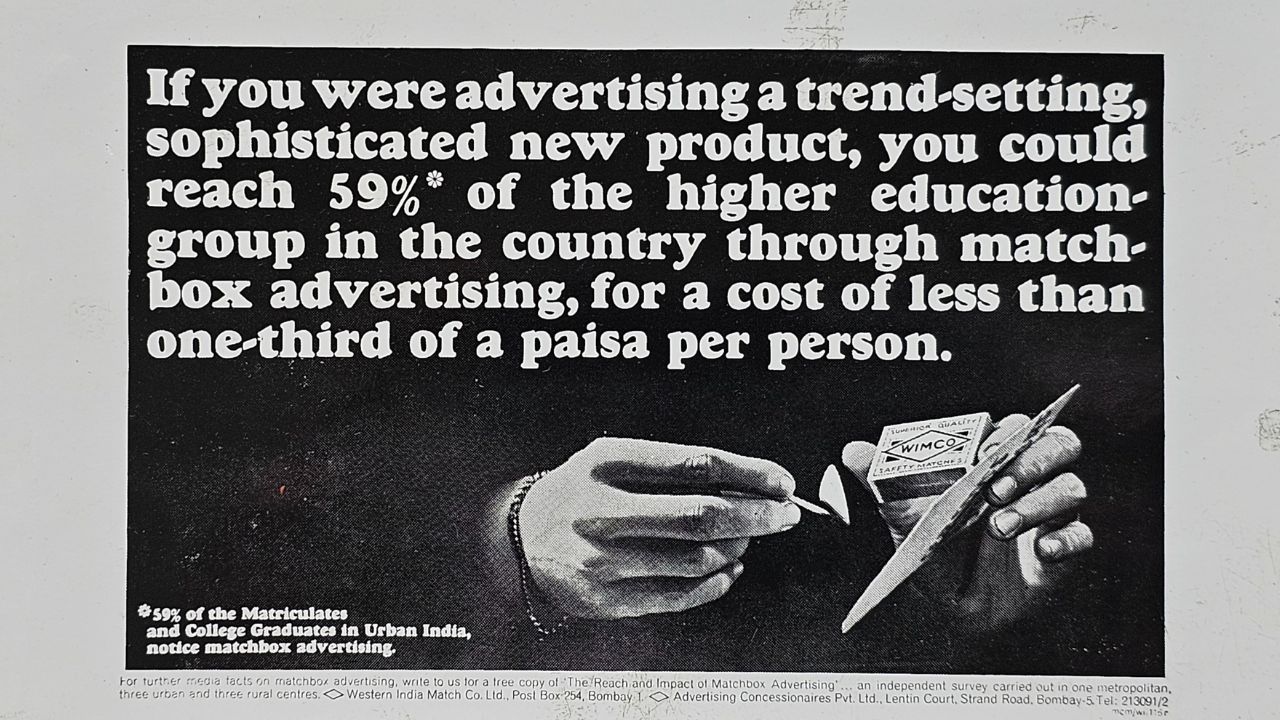Two hands are lighting a smoking pipe with the help of a Wimco matchbox. The background is pitch black. The words above the image read, “If you are advertising a product or service in urban India, you could reach 53% of the decision-making group through matchbox advertising, for less than one-fifth of a paisa per person.”
This was the era of the 1960s and the print ad was part of a campaign for Wimco matchsticks that ran for nine days.
“Can you imagine, a half page newspaper ad for Wimco matches?” questions Panna Jain, who conceptualised the campaign, in a conversation with Storyboard18.
MCM: The origin story
Jain reminisces the period of the 1960s and narrates the story in detail.
The veteran ad man was an employee of Everest Advertising and had just returned from the United Kingdom after having worked at Ogilvy for a year. One day, Jain, who dabbles in photography, was at Mitter Bedi’s photography studio.
There, he bumped into Kersy Katrak, an advertising personality credited with revolutionising Indian advertising. Katrak spotted ‘fire’ in Jain and expressed his desire to see the work Jain had done in London. When Jain was all set to display his portfolio, Katrak said, “Show me all your rejected work.”
Jain noticed the spark of creativity and advertising in Katrak and decided to join hands with him despite being an employee of Everest. The next question of Jain to Katrak was, “Where is your office?” The reply came, “There is no office. Let’s at least start working on something.”
Katrak, who stayed on Nepean Sea road, his car was their meeting place at Marine Drive, where the first meetings of MCM would take place.
And, that is how the seeds of MCM (Mass Communication and Marketing) were laid in 1965. Jain designed MCM’s logo sitting in his car at the back of a cigarette pack. Katrak was only 29 then and wanted to project MCM as ‘India’s DDB’, highlighted a report.
Katrak finally managed to find an office for MCM in Colaba and later, found a suitable residence in Bakhtawar Tower in Nariman Point, which is famous for being the residence of Ratan Tata (former chairman of Tata Sons). As reports suggest, the first assignment that came MCM’s way was for an egg company. But, stars shone bright in favour of MCM when Akbar Hydari paid a visit to the agency.
WIMCO: Birth of an unconventional campaign
Akbar Hydari — who passed away in 1998 — was the son of Sir Muhammad Saleh Akbar Hydari, an Indian politician and civil servant. He was the chairman of the Western India Match Company (WIMCO). When he approached MCM, his brief was to advertise the blank space on the back of the WIMCO matchbox.
Jain revealed a fact. During that era, most newspaper ads were Indian versions of foreign ads. For example, in ads for Lux, Liril, etc., which were created abroad, just the model would be replaced. The ads contained a headline, visual and a brand name.
When the conceptualisation process began, Jain raised the question, “Why does the body copy have to be the body copy? Why can’t it be the headline?”
When the idea of the campaign was presented, initially, Hydari could not connect the dots. But Katrak’s presentation skills won the confidence of the late chairman where he asserted that the ‘campaign would make waves and etch a special place for itself in the history of Indian advertising’. And, trust flowed in.
On the campaign, Jain worked as a visualiser, art director, and creative director. Katrak, who was also a poet, wrote the copy.

In every WIMCO ad, the two hands lighting the match were shown doing different things like lighting a lamp, a cigarette, an incense stick, etc. The hands were of different kinds of people from different parts of India, to highlight the product’s universality.
Fifty words comprised the headline for the half page ads that ran for nine consecutive days to maximise the campaign’s impact. In each advertisement, the headlines were long and different. The campaign spoke of the advantages of an ad at the back of a matchbox. And, each ad touched upon different selling target groups.

Since the budget was limited, the campaign found space mainly in the Times of India and was released in English. The papers, which used to be very rough then, there were restrictions imposed that in an advertisement, more than 40 percent black area could not be used, reminisced Jain.
Reproduction also posed a problem. Jain evolved a system called Quarter-Tone Bromide Artwork where new treatments and techniques were used. It is like a thin black outline around headline, individual pixels, that are manually touched-up to ensure sharp and clear reproduction even on very rough newsprint.
MCM and its stellar alumni
When WIMCO campaign appeared in print, it created a terrific impact and shone a spotlight on MCM in the Indian advertising world. The campaign swept off all the awards for the year including the title of ‘Campaign of the Year’.
MCM, which achieved spotlight through WIMCO campaign, is credited with producing luminaries who have gone on to shape Indian advertising with their pathbreaking campaigns. Luminaries include Ajit Balakrishnan (co-founder, Rediffusion), Arun Nanda (former chairman, Rediffusion), Arun Kolatkar (late art director), Kiran Nagarkar (late copywriter), Sudarshan Dheer (late corporate design specialist), Mohammed Khan (co-founder, Rediffusion and founder, Contract Advertising), Ravi Gupta (former chief executive officer, Trikaya Grey), Virupaksh Hiremath (late adman and design aficianado), Avinash Godbole (senior visualiser), and Anil Kapoor (former chairman, FCB Ulka).
As time passed by, MCM, which suffered bankruptcy, downed shutters in 1974. During its brief nine year run, the agency’s unconventional campaigns became the talk of the town which shone the light on the creative side of the agency. It went on to onboard clients like IBM, Bush Radios, CIBA, Gold Spot, Grindwell Norton, Debonair, Laxmi Vishnu Sarees, Godfrey Phillips, DCM, and Morarjee Mills.
With more than five decades having passed by since the campaign was released and MCM wound its operations, its legacy continues to evoke fond memories in the advertising world. And, as Jain put it, “WIMCO was the first campaign which brought MCM to prominence in Indian advertising.”
(Images source: Panna Jain)
Read More: O&M and Eastman Kodak: How the Kodak KB 10 campaign deepened their association
